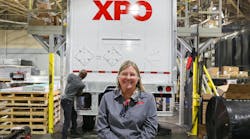There are nearly 19,000 lane miles of roadway throughout the five boroughs of New York City. Maintaining these roads is a big job that falls into the very capable hands of the Fleet Services division of New York's Dept. of Transportation (DOT).
The Fleet Services department is charged with insuring that on a daily basis over 2,600 vehicles are able to support all the agency's programs safely and efficiently. Jack Lawson, director of fleet services, says the work these vehicles do for DOT is enormous: “None of our primary goals could be met without the daily availability of the appropriate type and number of vehicles … in a safe working condition.”
Nearly 1,000 construction trucks are used to pave city roadways, maintain bridges and care for the transportation infrastructure in general. They are a mixed group that includes hundreds of dump trucks, tractor-trailers, sweepers, payloaders, aerial platform trucks, pavement rollers, and paving and milling machines.
Lawson notes the fleet also has several one-of-a-kind vehicles designed to do special jobs such as sewer cleaning, under-bridge inspection and air conditioning distribution, as well as night liner thermoplastic marking.
“DOT has 4,259 employees, 75% of which are drivers,” Lawson advises. “Their responsibilities range from just driving to operating complex equipment, such as the paving and milling machines.”
Lawson was first recruited by the City of New York to direct its huge ambulance fleet. He was appointed director of fleet maintenance of the New York Fire Dept. in 1993, before becoming director of Fleet Services for DOT in 1998. His specific expertise is in emergency vehicle towing and maintenance of auto, bus and truck fleets. From 1982 through 1991 he was manager of Penske Truck Leasing's Emergency Breakdown Center.
Fleet Services currently operates 13 maintenance shops throughout the five boroughs. According to Lawson, these shops operate throughout the normal workday, with special shifts available after hours.
“The later shifts support off-hour operations in addition to performing normal duties, such as preventive maintenance inspections and a full range of repairs,” Lawson notes.
“All maintenance programs depend on the periodic inspection of the equipment,” he adds, “and ours is no different. All the vehicles are brought into our repair facilities according to a schedule generated by an in-house maintenance system. Preventive maintenance is the key to a well running fleet.
“We measure our ability to meet our PM schedules, and during the past two years our rate of on-time inspections has improved. Inspections also increased by 9%. We are determined to continue with this improvement because the inspections help us identify problems before they become breakdowns,” he emphasizes.
Lawson says that in addition to in-house repairs, some work is contracted out. For example, Fleet Services contracts with dozens of vendors that do a wide range of services, including repairs to truck chassis and springs, radiators, lift cylinders, driveshafts, transmissions and other large components. Auto body and glass repair are also available under contract.


